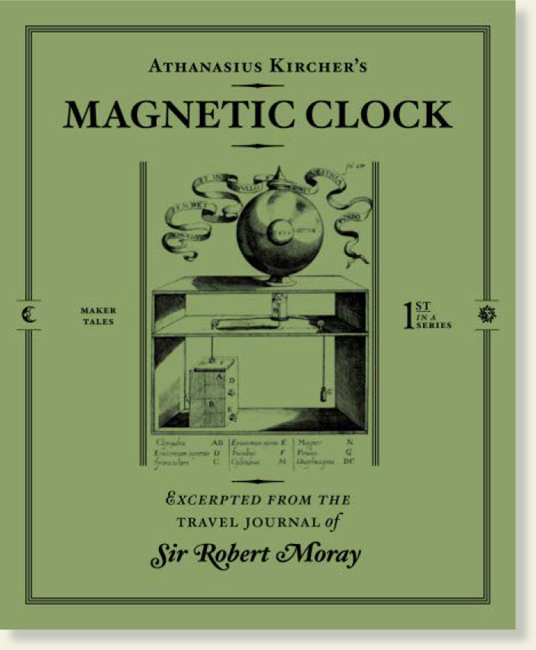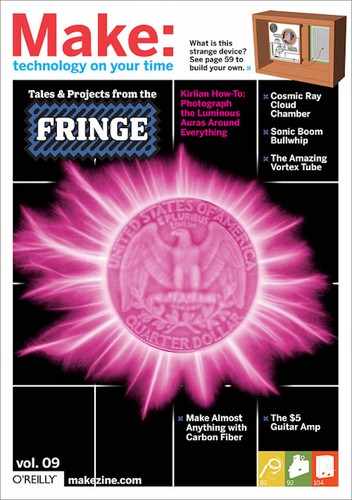The Essential Strangeness of Time
Reconstructing Athanasius Kircher’s magnetic clock.
Caroline Bouguereau, a French artist now living in Ireland, was commissioned by Stanford University Libraries in 2001 to reconstruct the magnetic clock described by German Jesuit polymath Athanasius Kircher (1602-1680). Jonah Peretti, emeritus director of R&D at Eyebeam in New York City, conducted the interview.
How did you decide which machine to build?
I liked the way the clock was a miniaturized model of the cosmos. It was a puzzle, an enigma ... a fish pointing mysteriously at the globe of the Earth, as it rotates slowly. The visual impact of the engraving appealed to me, and the magic of the machine: how were the globe and fish suspended? What cosmic force made the globe turn around? And, above all, why a fish? As an artist, I’ve worked with fish before. I also like curious scientific apparatus, machines that have an aesthetic appeal, or an unsettling, disorientating effect.
What were the biggest challenges in making the clock? Was it hard to make the clock work? What techniques did you have to learn?
The biggest challenge was to find a way to suspend the small sphere in the middle of the larger globe. In the reconstruction, I tried to imitate Kircher’s methods as closely as possible to produce the Baroque aesthetic effect of his device. To allow the sphere to appear to “float” within the globe, Kircher suspended it at the junction of two immiscible liquids of different densities. My concerns were which liquids to use for this purpose, and how to make the ball stay at the same position, right at the middle of the globe. Most of the organic solvents that worked well had serious risks. Acetonitrile, in particular, suggested enthusiastically by a Stanford chemistry professor, was apt to produce hydrogen cyanide on contact with air — probably not a good thing for an art exhibit in a public indoor space.
Did the project feel contemporary, historical, or both?
I had to immerse myself in the culture of the 17th century for the design; I had some freedom of design but there were very strict rules. The map of the world painted on the globe is an example. I copied a 350-year-old map. To paint on copper, I looked at how people did this in the 17th century — they rubbed the copper with garlic first, and scratched it to make the paint stick. I think the clock also has a very contemporary “feel,” though. I’ve always found time [to be] something very mysterious. We are so used to clock faces and digital representations of time that we have forgotten how strange it is. I think Kircher’s machine restores the essential strangeness of time.

Photography by Jason Forman
From an artist’s perspective, what’s important or interesting about Kircher?
Kircher is probably the most diverse and prolific kinetic artist of his time. Kircher is one person who really brought the worlds of mechanical ingenuity and arcane knowledge together in his Wunderkammer [curiosity cabinet]. With Kircher you never know what to take at face value.
![]() See the artist at makezine.com/09/kircher.
See the artist at makezine.com/09/kircher.

A floating fish always faces the current time (painted on a globe) in a reconstruction of Kircher’s celebrated magnetic clock from the 17th century. An ordinary water clock “magically” turns the globe with hidden magnets.
Thank you, subscribers!
We’re giving you a special, limited-edition booklet.

This miniature book, produced as a periodauthentic chapbook popular in Europe at the time, tells a historically speculative tale of one of the most remarkably creative inventors in history, Athanasius Kircher. This is the first volume in our forthcoming series of Maker Tales books, and this limited first edition is anticipated to quickly sell out.
In celebration of the start of MAKE’s third year, we’re giving all subscribers this Maker Tales booklet, which should arrive with your copy of MAKE 09. If you’re not a subscriber, you can still get a copy by purchasing one of a limited number available at makezine.com/store, or by subscribing at makezine.com/subscribe, using promotion code M7AK by May 15, 2007.
Make: Projects
Learn how to truly crack the whip by plaiting your own supersonic boomer. Or join the pinhole paparazzi and create unique panoramic images without touching a lens. If that doesn’t focus your attention, get cracker-jacked with a simple amp built from a cardboard box.

Photograph by Sam Murphy
The Bullwhip

Pinhole Panoramic Camera

The $5 Cracker Box Amplifier

